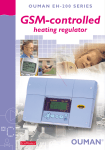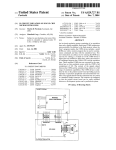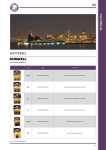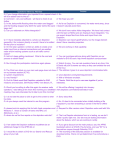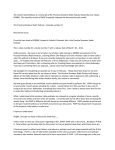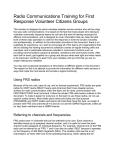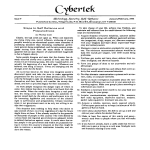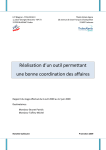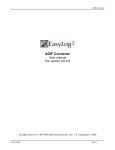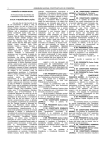Download English Version - Malta Amateur Radio League
Transcript
1 Smoking is prohibited at the Centre From the Editor Friends, I welcome you to another issue of this magazine for April 2011, which is issue 62 of this series. I also remind you that MARL is going to take part in the Spring Fair that is going to be held at San Anton Gardens on Saturday and Sunday 14 - 15 May, 2011. You have further information on the frequencies that are being used in the Libyan issue if one wants to listen to what is happening. We are still trying to be given an allocation on the frequency of 500 kĦz to be able to communicate with radio amateurs from a number of countries that have given an allocation on it to their radio amateurs. You have two photos of the dishes used by Joe 9Ħ1VW and Mansueto 9Ħ1GB during their tests on 10 GĦz. Note that Joe 9Ħ1VW was screened by the Madliena hill. Today you have the last information on electrical plugs that are used in different countries. The voltage that one finds in the different countries as well as the frequency which nowadays is 50 Ħz or 60 Ħz are going to be in the next edition of the Magazine. As you know, a controversy has been going on for some time ever since cellular telephony masts have started appearing on roofs on whether radio frequency radiation causes harm to persons. I am therefore going to start giving you some information on how you can take precautions to protect yours and others health. Also don’t forget that according to the license conditions the authorities have a right to come and inspect our stations, measure the signal strengths, and see what they consider suitable to protect health and that regulations are observed. Here I appeal to everyone not to use the yahoo group to alarm the people uselessly or create misunderstandings between the Committee and the members because that is what happens when one just writes without thinking on this group. Fools rush in where Angels fear to tread. I remind you that my new e-mail is 9h1avLaw at gmail dot com As always, I hope that you find the information in the magazine useful to you and if you have some article please leave it in my QSL box or you can send it to me on my e-mail 9h1avLaw at gmail dot com. Lawrence 9Ħ1AV/9Ħ9MĦR/9Ħ79AV 2 Spring Show I remind MARL members that as in past years MARL is going to take part in the Spring Show at the San Anton Gardens on Saturday and Sunday 14 – 15 May, 2011. Whoever wants to participate should inform the Secretary as soon as possible and advise him about your availability so that the Secretary can coordinate all the work. This is an opportunity for one to participate to continue showing our hobby to the public as well as for together with the family to be able to see and enjoy the show which was always good and beautiful and at the same time will be able to enjoy his/her hobby. Lawrence 9Ħ1AV/9Ħ9MĦR/9Ħ79AV Frequencies in the Libyan issue These are the latest frequencies that are being used in the Libyan issue. 4169.0 kHz – NATO Net; Some voice and Link 11 4196.0 kHz – NATO Net (Primary); Very Active 5368.0 kHz – Libyan GMMRA ALE Network 5725.0 kHz – UK Royal Navy 6688.0 kHz – French Air Force; Very Active 6690.0 kHz – Several players over No-Fly Zone 6712.0 kHz – French Air Force 6733.0 kHz – UK Royal Air Force 6761.0 kHz – USAF Global Aerial Refueling Operations 6877.0 kHz – USAF PsyOps from Commando Solo III 6884.0 kHz – Libyan GMMRA ALE Network 9019.0 kHz – UK Royal Air Force 9031.0 kHz – UK Royal Air Force 9375.0 kHz – Libyan GMMRA ALE Network 10125.0 kHz – Libyan GMMRA ALE Network 10315.0 kHz – German Air Force? 10404.0 kHz – Libyan GMMRA ALE Network 10405.0 kHz – USAF PsyOps from Commando Solo III 12311.0 kHz – French Air Force 14583.5 kHz – French Navy 16160.0 kHz – French Air Force 245.8500 MHz – UFO 10/11 SATCOM 260.0750 MHz – Sicral 1B SATCOM Lawrence 9Ħ1AV/9Ħ9MĦR/9Ħ79AV Earthquakes Since lately we have felt a few earthquakes you have a number of internet links where you will find information on them and also other information. 3 http://www.phys.um.edu.mt/seismic/ University of Malta http://www.emsc-csem.org/index.php?page=home#2 European – Mediterranean Seismogological Centre http://openmap.rm.ingv.it/gmaps/rec/en/Index.htm Last earthquakes recorded by INGV Network http://iside.rm.ingv.it/iside/standard/index.jsp?lang=en THE ITALIAN SEISMIC BULLETIN http://www.gein.noa.gr/services/monthly-list.html Institute of Geodynamics, National Observatory of Athens http://www.orfeus-eu.org/ Observatory and Recearch Facilities for European Seismology http://earthquake.usgs.gov/ US Geological Survey http://mednet.rm.ingv.it/ Mediterranean Network http://www.iris.edu/hq/ Incorporated Research Institutions for Seismology Lawrence 9Ħ1AV/9Ħ9MĦR/9Ħ79AV Internet webpages These are a few internet web-pages that I have no doubt you will find interesting because they are connected with our hobby. http://my.integritynet.com.au/purdic/ Electronic Projects http://www.morsex.com/building/atoz.htm Electronic Construction from A to Z http://www.tech-systems-labs.com/freesoftware.htm Free Software http://n4trb.com/AmateurRadio/RCA_Ham_Tips/rca_ham_tips.htm RCA Ham tips http://n4trb.com/AmateurRadio/GE_HamNews/ge_ham_news.htm GE Ham News Lawrence 9Ħ1AV/9Ħ9MĦR/9Ħ79AV 4 Electrical plugs and sockets Today I am going to continue giving you more information on the different electrical plugs that you find in different countries around the world. Type J This plug has the earth pin offset to one side and the pins are not in a straight line as one can see on the wall plug. These are known as three pin Swiss plugs and were developed in Switzerland as plugs that must be used in Switzerland and are known as SEV 1011 (Swiss 10 A/250 V). The wall plug also accepts plugs J and C. In Switzerland they also have other plugs that have only two pins, they have the same dimensions like the others, but the pins are hexagonal and not round, but these plugs can be inserted in both wall plugs and also in wall plugs CEE 7/16. There are also plugs like Type J that are not very common that are rated at 16 Amps whose pins are square. Equipment that takes more than 16 Amps must be permanently connected to the electrical system with branch circuit protection or by a high powered industrial connector. This plug is used in these countries. El Salvador, Ethiopia, Liechtenstein, Madagascar, Maldives, Rwanda, Switzerland. Type K These are Danish three pin plugs. Note that the earth pin is not exactly rounding. These plugs are technically known as Danish 10 A/250 V unearthed, which are the normal plugs in Denmark. Danish wall sockets also accept type C and F equipment plugs. Although equipment plugs Type E can also be inserted in these wall sockets, they should not be used with earthed equipment. A variation of this Danish plug known as DK 2-5a is for computer protection circuits from strong variations in supply voltage. They can be inserted in Type K wall plugs, but are designed in such a manner that normal Type K plugs cannot be inserted in the special computer type K sockets. Previously Danish wall sockets used to have a switch so as not to allow the live connector to touch while the plug was being inserted or withdrawn. Today sockets without switches are allowed, but they are required to have a cavity to prevent the pins from touching. However, their shape rarely allows the pins to touch. However, sockets in new installations in Denmark are required to have an earth connection. Old installations do not have this requirement, but must be protected by RCD/GFCI (HFI in Danish). From 2008, French sockets type E were allowed to be installed in Denmark, but not Type E. This plug is used in the following countries. 5 Bangladesh, Denmark, Faeroe Islands, Greenland, Guinea, Madagascar, Maldives, St. Vincent, Senegal, Tunisia. Type L These plugs are Italian and have three pins in a straight line with the centre pin connected to earth. These plugs are not polarized and can be inserted in either direction and are the type of plugs one finds installed in Italy. They are technically known as CEI 2316/VII. There are two models rated at 10 Amps and 16 Amps differing in both contacts diameter and spacing. In older installations an adapter may be required. The 10 Amp plug is similar to CEE 7/16 but has an earth pin and thus wall sockets CEI 23-16VII accept Euro plugs. The 16 Amp plugs have thicker pins which are a little further apart. The 16 Amp plugs are sometimes called northern European or Industrial, but this is not correct. While it is possible to insert plugs Type D and E in L wall sockets, you can damage the wall plug and they may become stuck. There are also two other Type L plugs that are much used in Italy. The first one is smaller and has a round hole in the middle and two 8-shaped holes above and below. These accept both Type L equipment plugs as well as Type C Euro plugs. The second socket is similar to Type F, but has a hole in the centre. It accepts equipment plugs Type E, F, C and L of 10 Amp rating, but also twice the size of a normal Type L socket. Sometimes these sockets also have extra holes to accept Type L 16 plugs. This plug is used in the following countries. Chile, Cuba, El Salvador, Ethiopia, Italy, Libya, Maldives, Syria, Tunisia, Uruguay. Tip M These plugs are used in South Africa, have three round pins like Type D but larger. They are technically known as BS 546 (South African 15 A/250 V) and are the plugs used in South Africa. This plug is used in the following countries. Hong Kong, Mozambique, South Africa, Swaziland. Lawrence 9Ħ1AV/9Ħ9MĦR/9Ħ79AV 6 Top: Joe 9Ħ1VW antenna Baħar iċ-Ċagħak 10GĦz SSB 2W 03.04.2011 59+ Bottom: Mansueto 9Ħ1GB antenna Iż-Żurrieq 10 GĦz SSB 03.04.2011 59+ Reflections from communications tower at centre of pictures 7 AGC (Automatic Gain Control) : Which settings to use ? Thanks to Robin, 9Ħ1ZZ for the following interesting Article on AGC The AGC controls in most communications receivers are readily accessible for the operator. Ham transceivers allow for this also, but rarely does the user’s manual provide much guidance on the choice of settings or on the impact of using inappropriate values. I have looked at some Kenwood, ICOM and Yaesu manuals, and extracted the following consolidated advice: • AGC should be set to S (for slow) when working AM, SSB and slow CW. • AGC should be set to F (for fast) while tuning and when working high speed CW or FSK. • AGC should be switched OFF when working FM. Since I work mostly “Digital Modes”, I realised I needed to do more research on AGC in order to optimise my settings and be able to pull out the weak DX signals better. The results of my detailed study were a bit surprising (to me), so I feel I could usefully share these findings with our members, who might find them helpful. Background In general, there are three chains of amplification in receivers (fig.1) : RF (radio frequency), IF (intermediate frequency) and AF (audio frequency) RF Gain Radio Frequency (RF) AF Gain Intermediate Frequency (IF) Audio Frequency (AF) Fig.1. Three chains of amplification RF chain The sensitivity of the receiver varies according to frequency band. Consequently pre-amps and attenuators may be switched in/out of circuit when bands are changed. It is extremely important to avoid saturating the RF stages with strong out-of-band (local broadcast) stations, so there are also RF band-pass filters introduced automatically according to the band selected. For the user, it is common to allow control of the pre-amps and attenuators, and of course on the front panel there is always the variable RF gain control for finer adjustments. The critical issue here is that the RF chain should amplify all in-band signals linearly. 8 IF chain This is fixed frequency amplification, where most of the receiver’s gain is obtained, as well as providing narrow band selectivity. For various reasons, the chain may be implemented as several stages each with different fixed frequencies. In modern transceivers, the user is given some control, for selectivity and interference suppression. The AGC circuitry varies the gain of the IF chain, depending on the AGC settings. AF chain Usually the AF gain is set by the user so that the audio output is at a convenient level for listening. However, the characteristics of the other amplification chains are critical when searching for weak signals in the presence of noise. The AGC works to bring the detected signals (and noise!) to an appropriate level for the input to the audio amplifier. Further tailoring of the AF chain’s characteristics assists in enhancing the wanted signals. As noted already, the AGC acts on the IF amplifier chain as indicated in Fig.2. Signals are detected at the output of the IF chain and feedback applied, varying the gain of the amplifiers, to bring the signals to a preset level. These parameters cannot be altered directly by the user. RF IF Signal Detector IF Amplifier Chain AF Mixer S Meter Gain Control CContro AGC Feedback Set AGC response time Fig.2. AGC feedback diagram The AGC circuitry features fast attack / slow release. In practice, it is usual for the AGC circuit to respond in less than 0.1 second, and the user chooses a release time up to several seconds. Depending on the characteristics of the received signals, the AGC release will be more or less effective. The summary at the beginning of this article shows at which settings the transceiver manufacturers believe their equipment works best. Effects of AGC S-meter Although the user cannot vary the gain, the amount of feedback the AGC applies is presented to the operator, as an indication on the S-meter. So, the stronger the incoming signal, the more 9 feedback is applied and the higher the S-meter reading. This also explains why the S-meter changes when the RF gain control is varied, since the AGC attempts to keep the detected signal level constant. Notice also that if the AGC is switched OFF, there is no feedback and the S-meter reading no longer represents the received signal strength. FM Now, it is a fact that varying the feedback will not only alter the gain, but also influence the phase shift through the amplifier chain. So, normally, as the detected signal changes in amplitude, AGC will be applied, varying both the gain and the inherent phase shift, continuously. This could cause potential problems to FM discriminators; so for FM signals, the AGC is automatically disabled. Digital Modes Modern transceivers have a rear panel connector specifically for users to access the detected signals prior to the AF amplification chain. Digital modes use this facility. The detected output is digitized directly (using the computer’s sound card) for audio frequency processing by computer, as shown in Fig.3. Sound cards have a dynamic range of around 100dB, so there is no need for AGC. However, care is needed, to ensure that the signal level never exceeds the maximum specified for the sound card. Amongst other undesirable effects, overloading the input a/d converter will result in nonlinearity, which shows up as inter-modulation products (multiple sidebands). COMPUTER Monitor Screen Display Receiver Sound Card A/D converter Digital Processing Unit AF output Keyboard Fig.3. Connection for processing digital modes by computer If AGC is active, it is based on the detected signal, averaged over the audio bandwidth of the detector. In most ham transceivers, this is normally about 2500Hz. However, recent developments include DSP (digital signal processing) in the IF chain to adjust the frequency response for different situations, which may result in narrower variable IF bandwidths. 10 Many digital modes have bandwidths of just a few Hz, so there could be a number of different signals present within the audio passband. Several digital modes may even be superimposed. With the AGC operating, all the signals in the passband will be affected. So if there are a few (or even just one) very strong signals, the AGC will lower the overall gain and any weaker signals within the passband may disappear. Some digital modes rely on phase modulation. As already mentioned when considering FM (frequency modulation), continuously altering the feedback in the IF chain will cause the phase of the signals to vary. The computer programs implementing phase sensitive demodulation algorithms may find it difficult to handle these unwanted phase variations. Fig.4. Typical screen shot of waterfall S-meter readings will be meaningless for digital modes, regardless whether AGC is used or not. As explained, the AGC feedback (and the S-meter indication) is based on the average detected signals over the full audio passband, and not the amplitude of individual narrow band digital signals. Digital mode software designers have found another way to represent signal strengths, by colour coding the waterfall displays (fig.4), according to the amplitude of the different signals. Conclusion. General rules when working Digital Modes: • AGC is neither necessary nor desirable and should be switched OFF. • Saturation (RF and AF) may be avoided by appropriate use of the RF controls. Robin 9Ħ1ZZ Thanks to Robin, 9Ħ1ZZ for this article This space is blank due to the difference in text length between the Maltese and English versions. 11 Whoever has still not paid his membership should do so if he wants to remain a MARL member. The Financial Secretary is always ready to accept your membership fee whenever the MARL Centre is open or if you cannot come pay by cheque payable to MARL We remind you that the MARL Centre is open every Tuesday and Thursday between 6.00 p.m. and t-8.00 p.m. and Sunday between l-10.00 u and 12.00. I remind MARL members that as in past years MARL is going to take part in the Spring Show at the San Anton Gardens on Saturday and Sunday 14 – 15 May, 2011. While I encourage everyone to participate, whoever wants to participate should inform the Secretary as soon as possible and advise him about your availability so that the Secretary can coordinate all the work. Since as you know lately a lot of writings have appeared on newspapers on cell phones antennas and reasons of health and safety we are going to start giving you some information on precautions that everyone should take for his station to be according to international standards. Thus, everyone will be certain that he will not be exceeding international limits and the authorities will be able to certify that he is really working within international limits. Therefore be attentive for information that we will give you later on. Be attentive and become members in the yahoo group to be fully informed with the latest activities that we intend to hold. Do not forget that we may have activities which may not be able to appear on this magazine because it may have already been issued and therefore the notice will be sent on the yahoo group. Send an e-mail to Ivan, 9H1PI ivan.privitera at gmail.com to become members in the group. We remind you that whoever wants to can download the Magazine from www.9h1mrl.org/newsletter.htm Lawrence 9Ħ1AV/9Ħ9MĦR/9Ħ79AV 12












